Numerical and Experimental Investigation of the Through-Thickness Strength Properties of Woven Glass Fiber Reinforced Polymer Composite Laminates under Combined Tensile and Shear Loading
Abstract
1. Introduction
2. Experiment Procedure
2.1. Materials
2.2. Instrumentation
2.3. Finite Element Analysis
3. Results and Discussion
3.1. Combined Interlaminar Tensile and Shear Tests
3.2. Finite Element Analysis
4. Conclusions
- The cross specimens with the stacking angles tended to fracture near the reduced section, whereas some specimens with stacking angle fractured at the radius point where the maximum interlaminar shear stress would be applied, and all specimens with the stacking angle fractured near the contact points between the specimen and the jigs where the stress concentration occurred.
- From the predicted interlaminar stress distributions obtained by FEA, it was found that the combined interlaminar tensile and shear stress fields were generated in the reduced sections of the specimens with the stacking angles and .
- Considering the predicted interlaminar stresses at fracture locations calculated by FEA, it was confirmed that the interlaminar tensile strength decreased while the interlaminar shear strength increased as the stacking angle increased. Furthermore, the relationship between the combined interlaminar tensile and shear strengths obtained from FEA were actually almost consistent with the prediction based on Hoffman and Mohr-Coulomb failure criteria when the stacking angle was , and .
- We derived the tensile and shear strengths from the FEA with stacking angle and reference data [16] of the short beam shear test, respectively, and these values were determined by = 20.4 MPa and = 46.1 MPa. On the other hand, from this study, the interlaminar tensile and shear strengths of the GFRP composite laminates with each stacking angle were expected at = 19.2 MPa, = 11.1 MPa, = 17.5 MPa, = 14.4 MPa and = 25.0 MPa, respectively.
Author Contributions
Funding
Conflicts of Interest
References
- Takeda, T.; Shindo, Y.; Fukuzaki, T.; Narita, F. Short beam interlaminar shear behavior and electrical resistance-based damage self-sensing of woven carbon/epoxy composite laminates in a cryogenic environment. J. Compos. Mater. 2014, 48, 119–128. [Google Scholar] [CrossRef]
- Cai, D.; Zhou, G.; Silberschmidt, V. Effect of through-thickness compression on in-plane tensile strength of glass/epoxy composites: Experimental study. Polym. Test. 2016, 49, 1–7. [Google Scholar] [CrossRef][Green Version]
- Gan, K.W.; Wisnom, M.R.; Hallett, S.R. Effect of high through-thickness compressive stress on fiber direction tensile strength of carbon/epoxy composite laminates. Compos. Sci. Technol. 2014, 90, 1–8. [Google Scholar] [CrossRef]
- ASTM D7291/D7291M-07. Standard Test Method for Through-Thickness “Flatwise” Tensile Strength and Elastic Modulus of A Fiber-Reinforced Polymer Matrix Composite Material; Annual Book of Standards; ASTM International: West Conshohocken, PA, USA, 2007.
- Gerlach, R.; Siviour, C.R.; Wiegand, J.; Petrinic, N. In-plane and through-thickness properties, failure modes, damage and delamination in 3D woven carbon fiber composites subjected to impact loading. Compos. Sci. Technol. 2012, 72, 397–411. [Google Scholar] [CrossRef]
- Takeda, T.; Narita, F.; Shindo, Y.; Sanada, K. Cryogenic through-thickness tensile characterization of plain woven glass/epoxy composite laminates using cross specimens: Experimental test and finite element analysis. Compos. Part B 2015, 78, 42–49. [Google Scholar] [CrossRef]
- Hoffman, M.; Zimmermann, K.; Bautz, B.; Middendorf, P. A new specimen geometry to determine the through-thickness tensile strength of composite laminates. Compos. Part B 2015, 77, 145–152. [Google Scholar] [CrossRef]
- Narita, F.; Tanaka, C.; Suzuki, M. Interlaminar tension-tension fatigue of woven glass fiber reinforced plastic composite laminates at low temperatures. J. Compos. Biodegrad. Polym. 2018, 6, 28–33. [Google Scholar] [CrossRef]
- Hahn, H.T.; Pandey, R. A micromechanics model for thermoelastic properties of plain woven fabric composites. J. Eng. Mater. Technol. 1994, 116, 517–523. [Google Scholar] [CrossRef]
- Miura, M.; Shindo, Y.; Takeda, T.; Narita, F. Interlaminar fracture characterization of glass/epoxy composites under mixed-mode II/III loading conditions at cryogenic temperatures. Eng. Fract. Mech. 2012, 96, 615–625. [Google Scholar] [CrossRef]
- Hoffman, O. The brittle strength of orthotropic materials. J. Compos. Mater. 1967, 1, 200–207. [Google Scholar] [CrossRef]
- Chen, W.F. Limit Analysis and Soil Plasticity; Elsevier Scientific Publishing Company: New York, NY, USA, 1975. [Google Scholar]
- Takagi, T.; Miya, K.; Takeuchi, Y.; Tani, J. Unite element slip analysis of multi layer beam plate based on a composite theory. Fusion Eng. Des. 1989, 7, 255–267. [Google Scholar] [CrossRef]
- Kitamura, K.; Yamamoto, T.; Uchida, T.; Moriyama, H.; Yamamoto, J.; Nishimura, A.; Motojima, O. Cryogenic shear fracture tests of interlaminar organic insulation for a forced-flow superconducting coil. IEEE Trans. Magn. 1994, 30, 1879–1882. [Google Scholar] [CrossRef]
- Miura, M.; Shindo, Y.; Takeda, T.; Narita, F. Effect of damage on the interlaminar shear properties of hybrid composite laminates at cryogenic temperatures. Compos. Struct. 2010, 93, 124–131. [Google Scholar] [CrossRef]
- Shindo, Y.; Tokairin, H.; Sanada, K.; Horiguchi, K.; Kudo, H. Compression behavior of glass-cloth/epoxy laminates at cryogenic temperatures. Cryogenics 1999, 39, 821–827. [Google Scholar] [CrossRef]
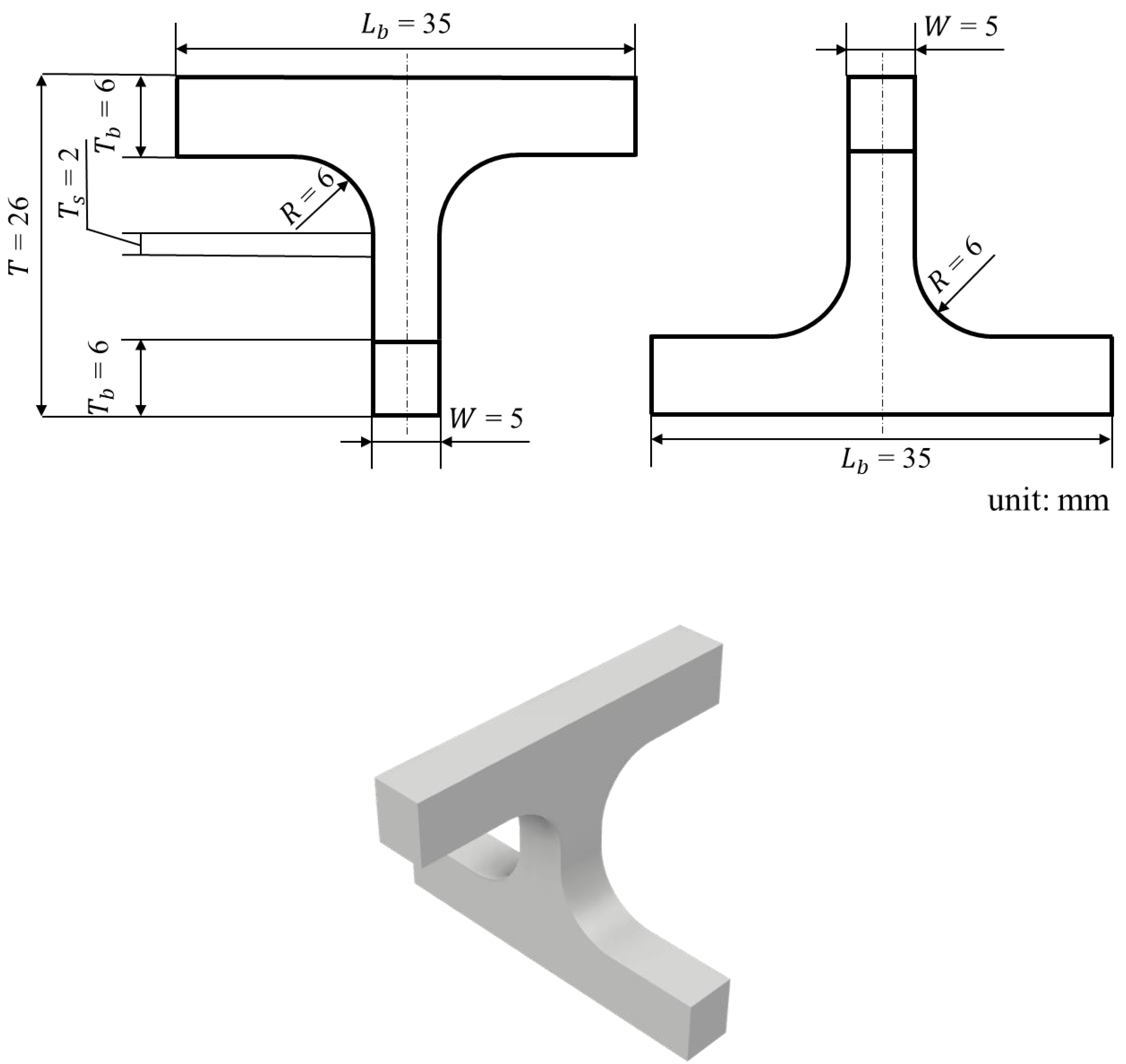
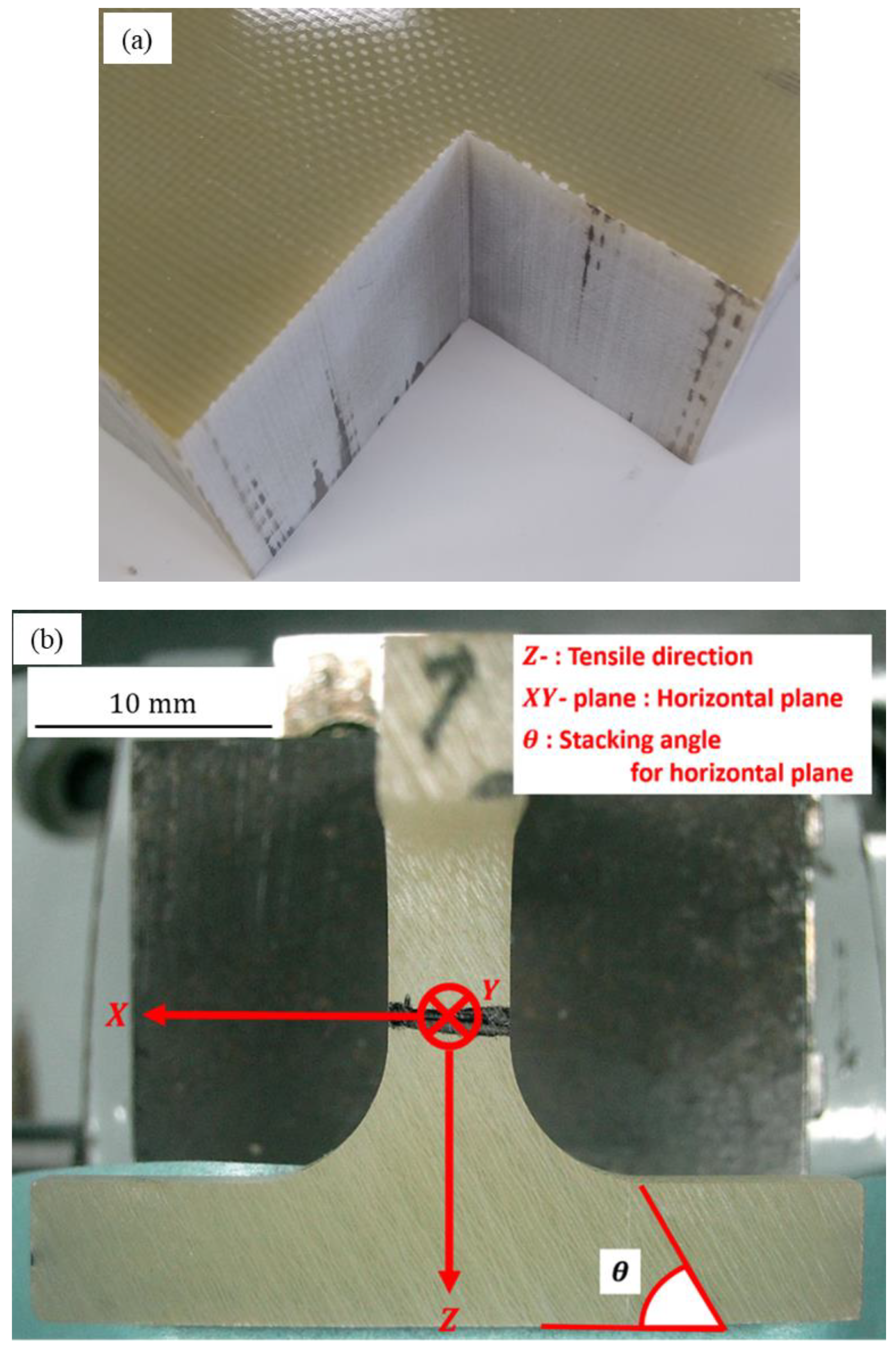
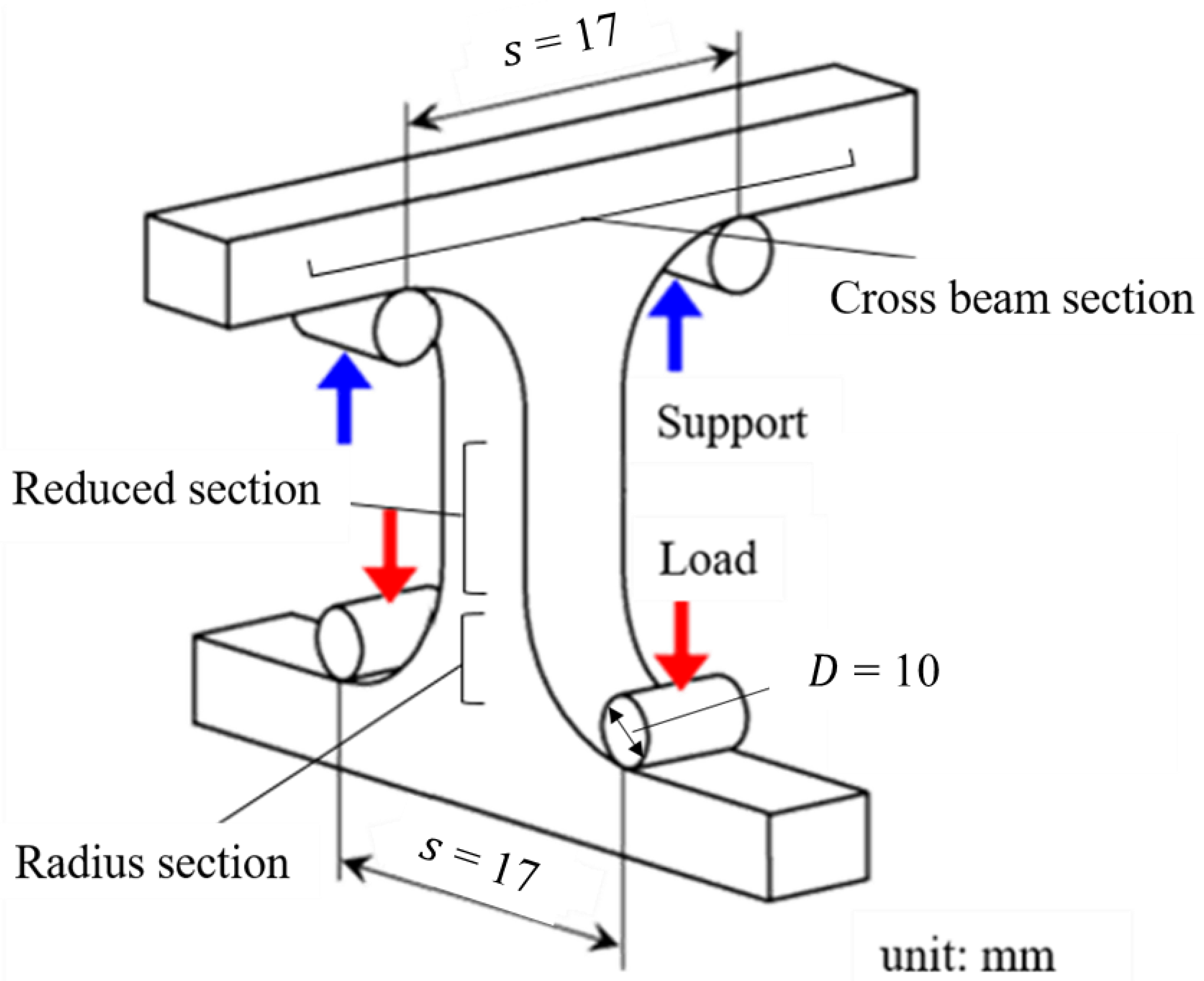
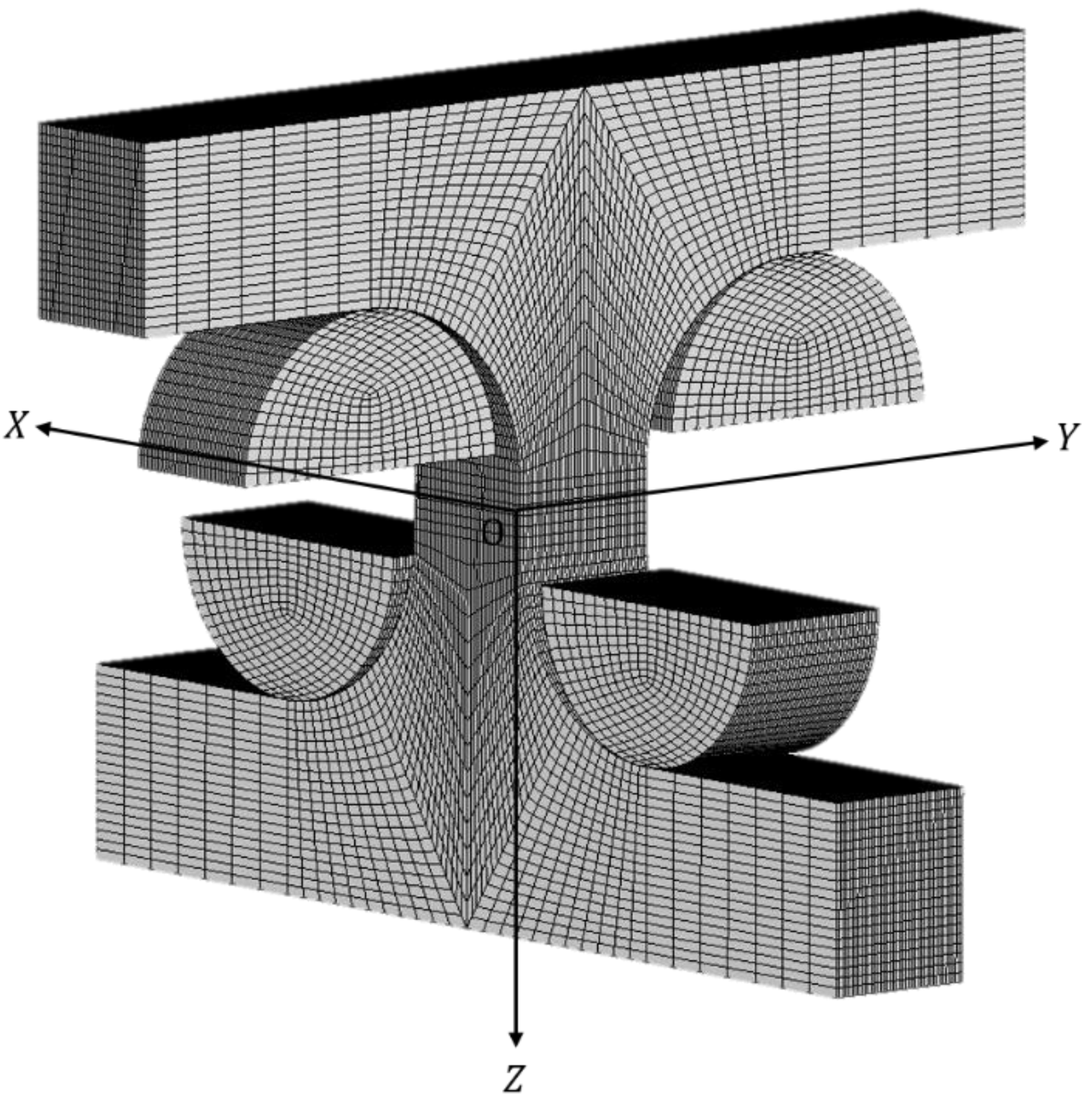

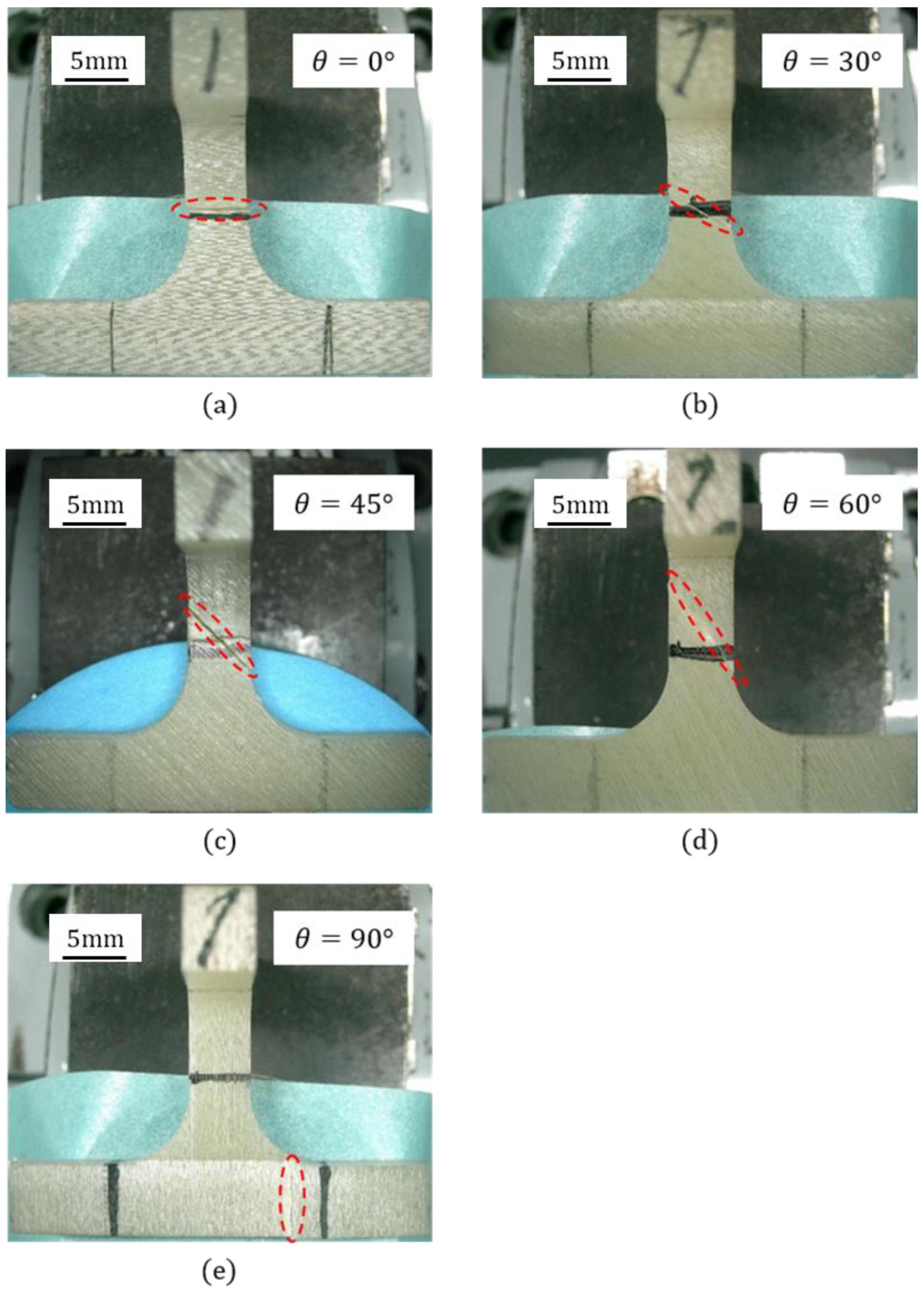


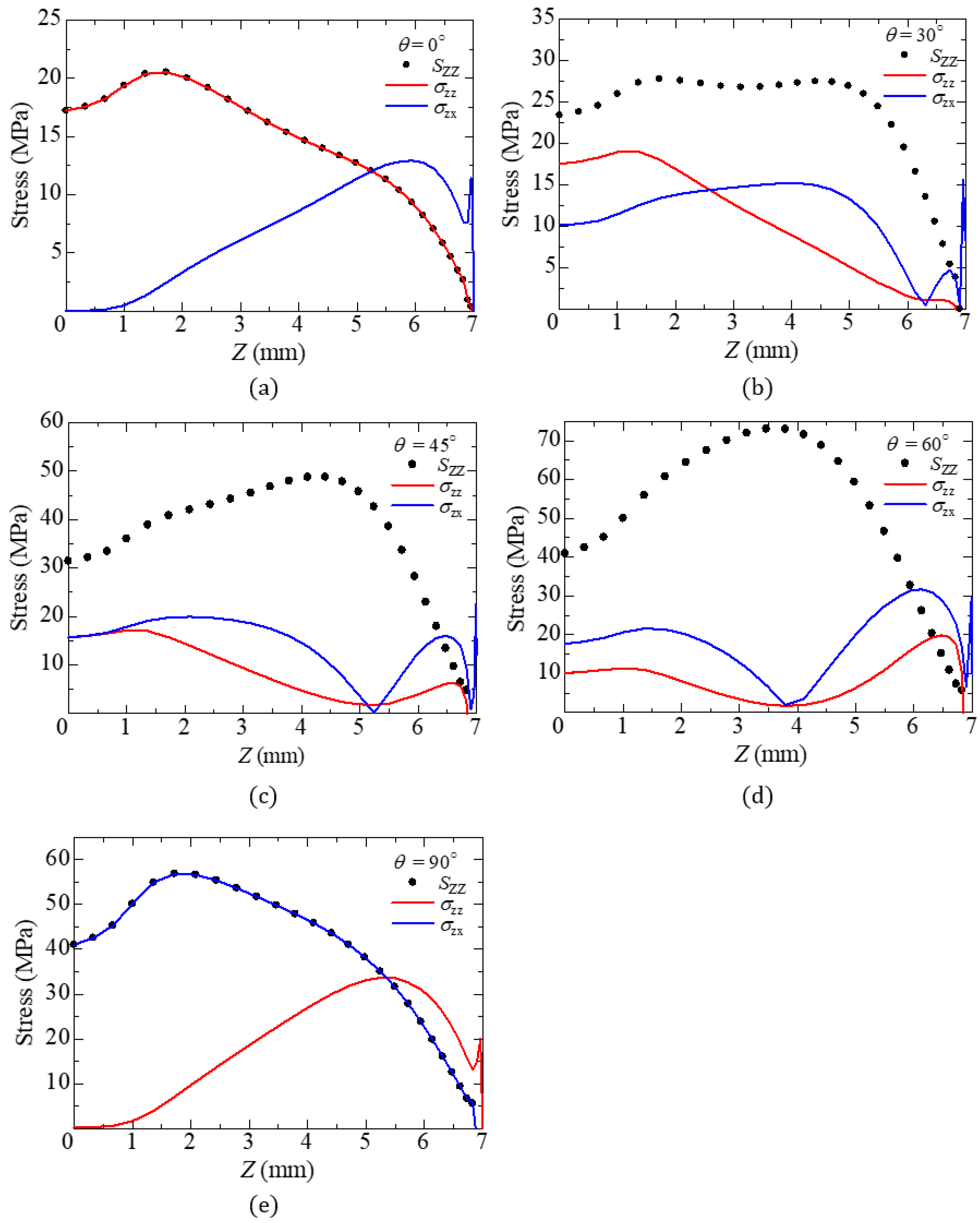
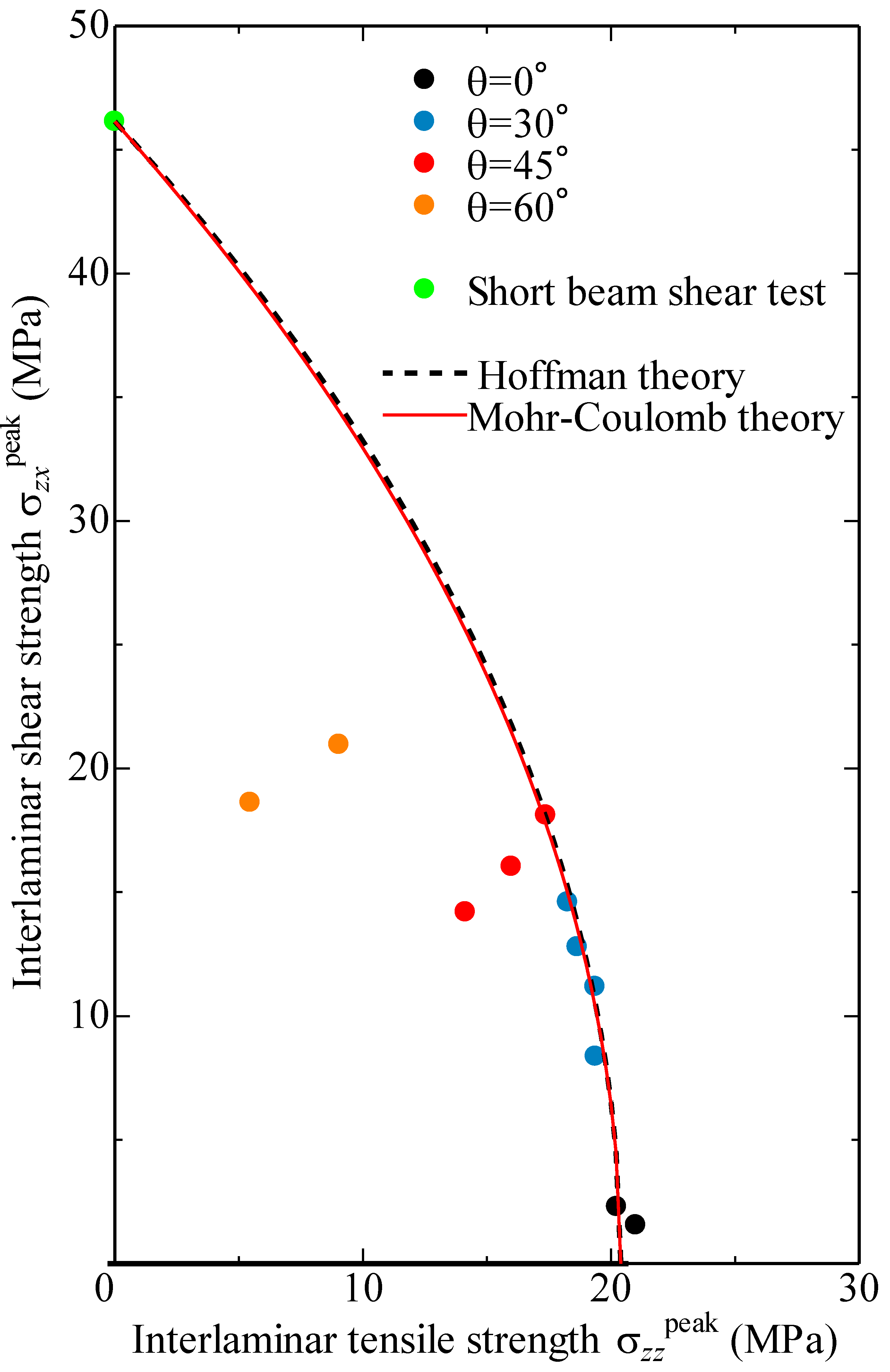
| (GPa) | |
| (GPa) | |
| (GPa) | |
| (GPa) | |
| (GPa) | |
| (GPa) | |
| Stacking Angle | Fracture Stress [Mpa] | Fracture Angle | Fracture Location [mm] |
|---|---|---|---|
| 17.35 | −1.68 | ||
| 18.10 | −1.42 | ||
| 20.02 | 1.65 | ||
| 26.62 | −0.35 | ||
| 26.39 | −0.82 | ||
| 23.72 | 1.48 | ||
| 34.26 | 1.00 | ||
| 35.68 | 0.00 | ||
| 32.24 | −0.21 | ||
| 49.71 | 2.71 | ||
| 41.04 | 1.81 | ||
| 47.92 | 6.58 | ||
| 43.12 | 6.55 |
© 2020 by the authors. Licensee MDPI, Basel, Switzerland. This article is an open access article distributed under the terms and conditions of the Creative Commons Attribution (CC BY) license (http://creativecommons.org/licenses/by/4.0/).
Share and Cite
Kanno, T.; Kurita, H.; Suzuki, M.; Tamura, H.; Narita, F. Numerical and Experimental Investigation of the Through-Thickness Strength Properties of Woven Glass Fiber Reinforced Polymer Composite Laminates under Combined Tensile and Shear Loading. J. Compos. Sci. 2020, 4, 112. https://doi.org/10.3390/jcs4030112
Kanno T, Kurita H, Suzuki M, Tamura H, Narita F. Numerical and Experimental Investigation of the Through-Thickness Strength Properties of Woven Glass Fiber Reinforced Polymer Composite Laminates under Combined Tensile and Shear Loading. Journal of Composites Science. 2020; 4(3):112. https://doi.org/10.3390/jcs4030112
Chicago/Turabian StyleKanno, Teruyoshi, Hiroki Kurita, Masashi Suzuki, Hitoshi Tamura, and Fumio Narita. 2020. "Numerical and Experimental Investigation of the Through-Thickness Strength Properties of Woven Glass Fiber Reinforced Polymer Composite Laminates under Combined Tensile and Shear Loading" Journal of Composites Science 4, no. 3: 112. https://doi.org/10.3390/jcs4030112
APA StyleKanno, T., Kurita, H., Suzuki, M., Tamura, H., & Narita, F. (2020). Numerical and Experimental Investigation of the Through-Thickness Strength Properties of Woven Glass Fiber Reinforced Polymer Composite Laminates under Combined Tensile and Shear Loading. Journal of Composites Science, 4(3), 112. https://doi.org/10.3390/jcs4030112







